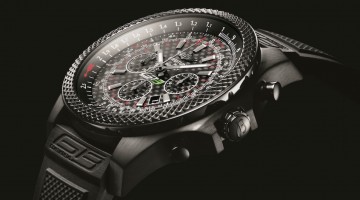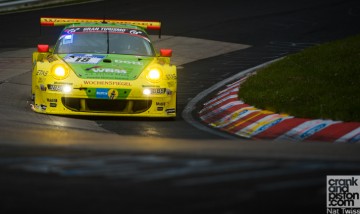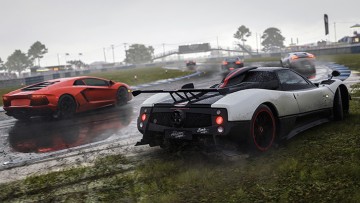Having learnt (hopefully) from my previous mistakes, this time I am working with a much shallower depth of field and closer cropped frames in order to draw attention away, slightly, from the backdrop and keep the Chevy as the focal point. With this I should hopefully find a 50:50 balance between subject and landscape, a key ratio in automotive photography. Remembering my lessons with the silver Passat Sport, I’m also using the shadows as well as the flashes to alter the perspective: keeping a proportion of the saloon out of direct sunlight allows some of the finer details like the bodylines to stand out, and not just disappear into the reflective silver ether.
One location and three shots down, I decide to mix up the series by changing locations for my final three shots, and a nearby staircase is ideal. It allows me to experiment with a dimension I’ve only hinted at during the series, namely shooting from above. Again, it’s a tricky art to perfect. With so few details to work with on the roof, the Malibu can appear flat against the backdrop if not treated correctly. To counter that, I throw some forced perspective into the foreground by making use of the stairs’ geometric nature and the shadows bouncing off them. It’s a bit MC Escher, but it gives the shots a nice look.
One other problem though is much more down to earth: cramp. Even though I remember to hold my breath whilst taking a shot (which stops the lens moving up and down), several frames that I take back-to-back are very different. In some, the Malibu has shifted in the frame by as much as two inches, simply because small vibrations through my arms have pushed the lens askew. I remedy this by lining up the crosshairs in the lens with part of the backdrop as well as using my palm against the body of the camera for a more solid base. It sounds simple, but standing perfectly still is one of the most difficult tests I’ve faced yet. And since some, if not most, of these shots have been taken whilst I’m kneeling down, my knees soon start to feel the strain.
By the end of a long morning’s work, I have seven images, a stiff back, a ruined right kneecap, a forehead slick with perspiration, a shirt that’s changed colour, a brain no longer capable of reciting the alphabet, and a set of behind the scenes photography that could describe ‘knackered’ in the dictionary. It’s all incredibly draining, and this challenge has given me a fresh perspective on life behind the lens. It’s so much more than point and shoot, and I’m fully aware I still have years to go before I’m even close to being semi-professional. But at the same time, I’ve learnt a lot about the fineries of lighting, balance, perspective, and depth of field. Working with natural light is hard enough, and throwing artificial lighting in as well is an incredibly complex balancing act. And while it is still quite rough, I really am very proud of my finished Chevrolet Malibu set, which I feel shows the car in a light I would have been unable to replicate just one month ago. As far as three short lessons go, I’d say it’s been a success.
But of course, that’s for you to decide.
| Chevrolet | Malibu LTZ |
|---|---|
| Engine: | Inline 4cyl / 2384cc |
| Power: | 263hp @ 6900rpm |
| Torque: | 166lb ft @ 4600rpm |
| Transmission: | Six-speed automatic |
| Front suspension: | MacPherson strut |
| Rear suspension: | Four-link |
| Brakes: | Four-wheel ABS |
| Wheels: | 17-inch front and rear |
| Tyres: | N/A |
| Weight (kerb) | N/A |
| 0-100kph: | 10.2sec |
| Top speed: | 206kph |



